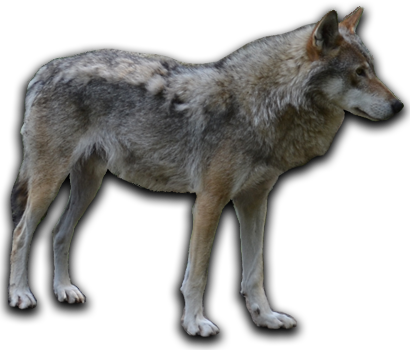Tag Archives: clay
Dark red saya Japanese Samurai Katana clay tempered sharp sword can cut bamboo
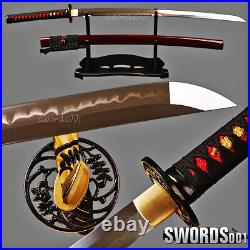
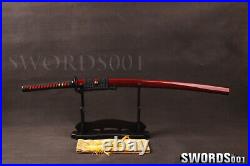
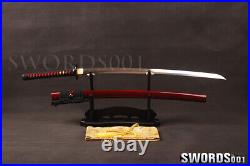
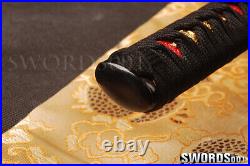
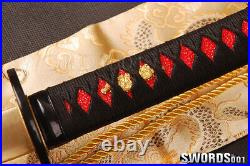
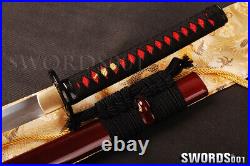
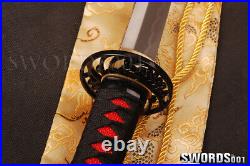
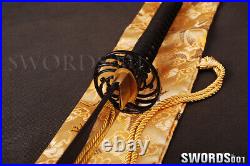
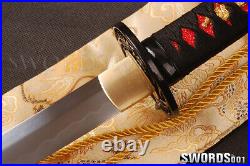
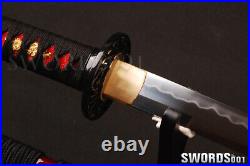
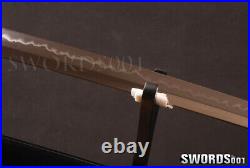
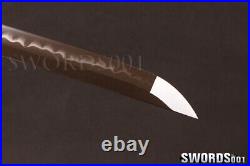

Dark red saya Japanese Samurai Katana clay tempered sharp sword can cut bamboo. Were one of the traditionally made Japanese swords (nihonto) that were used by the samurai of ancient and feudal Japan. The katana is characterized by its distinctive appearance: a curved, single-edged blade with a circular or squared guard and long grip to accommodate two hands. Samurai katana as a weapon is famous for its beautiful shape. They are used as art collection and the symbol of samurai soul. Our sword allows you to make a collection or to send to friends as a present. The blade of this sword is made of. It is clay tempered. The high-performance blade has very good toughness and does not deform when bent at 90 degrees. The hardness is as high as 60. Cutting the wire does not hurt the blade. It can be used in battle or for display. We would highly recommend it as a gift. Anyone would be thrilled to receive a gorgeous katana sword as a gift! OVERALL LENGTH: 103 cm / 40.5 inch BLADE LENGTH: 70 cm / 27.6 inch TSUKA LENGTH: 26 cm / 10.24 inch BLADE WIDTH: 3.2 cm / 1.26 inch BLADE THICKNESS: 0.7 cm / 0.28 BLADE CRAFT: fully hand forged, water quenching BLADE MATERIAL: T10 carbon steel. Clay tempered, real hamon. BLADE SHAPE: Shinogidukuri NAKAGO: full tang KISSAKI: medium (chukissaki). TSUKA(HANDLE): hard wood core, Hineri maki MEKUGI: 2 bamboo pegs TSUKA-ITO: black wrapping cord SAMEGAWA: red genuine rayskin FUCHI / KASHIRA / MENUKI: alloy TSUBA(HAND GUARD): alloy HABAKi & SEPPA: brass SAYA. Lacquered wooden scabbard with black specialized sageo. 1 sword with saya. (No display stand and other fittings along with). Before being quenched, a special clay mixture can be applied onto the blade to harden the edge and obtain different hardness on the blade. The clay mixture was a special recipe and considered a crucial trade secret, guarded protectively by sword making masters. It would contain such things as feathers, powdered bones, grass, etc. And would be applied to the edge of the blade before being quenched. During quenching, a chemical reaction between the clay mixture and the hot steel occurs during the sudden temperature drop and carbon is fed into the blade in high amounts, creating an extremely tough edge. A clay hardened blade can only be quenched in water, thus increasing the defect rate even more. Another way for clay tempering is to apply clay along the blade but let edge exposed. Thus, while quenching the blade into water, the uncovered edge will cool down suddenly, but the rest of blade will cool down slowly. Such differential temperature change results in the different hardness of the blade. So the edge is tough enough to cut, where the back of blade is soft /flexible enough to absorb the impact during cutting. Such quenching process usually will leave beautiful wavy tempered line on the blade, as known as “hamon” in Japanese swords term. If you don’t like the original mountings, you can choose the favorite ones from the options. Handle wrapping cord and saya cord should be the same color. If you only want to change one of them to another color, please inform of it specially. We can engrave English words, Chinese Characters on the blade for free. We can add or remove the machine-made wavy hamon for free. Usually thought be used for bloodletting only. It is also used to lighten the weight of the sword. We can add or remove Bo-hi for free. Most of our blades are sharp. We can also make the blade unsharpened for free if you require. The price varies from different swords. International Buyers – Please Note. Please contact with us before you leave feedback. We will try our best to solve the problem for you, thank you. Sometimes, you may not get our reply immediately due to the time difference among each country. However, please be assured that we’ll strive to reply you as soon as possible once we got your messages. This item is in the category “Collectibles\Knives, Swords & Blades\Swords & Sabers\Asian\Japanese”. The seller is “swords001″ and is located in this country: CN. This item can be shipped worldwide.
- Type: katana
- Tang: Full
- Handle Material: Wood
- Blade Material: Carbon Steel
- Theme: Samurai
- Dexterity: Right-Handed
- Edge: Single, Curved
- Handedness: Double-Handed
- Brand: SJ SHI JIAN
- Color: Red
- Country/Region of Manufacture: China
- Original/Reproduction: Original
- Style: Japanese

Japanese Samurai Sword Clay Hardened Real Hamon Rosewood Tachi Saya Fittings
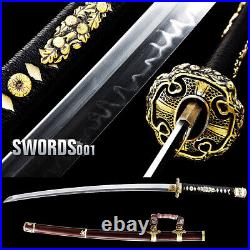
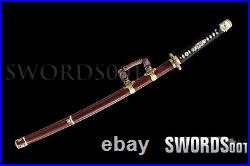
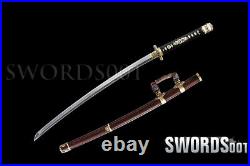
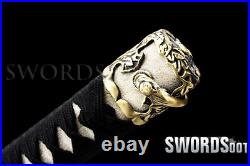
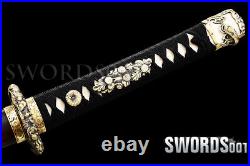
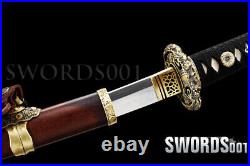
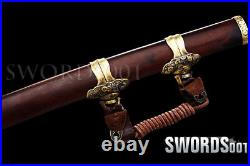
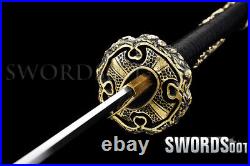
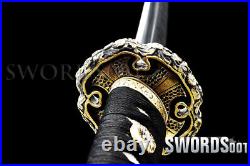
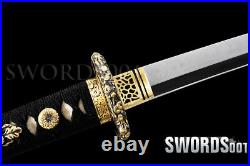
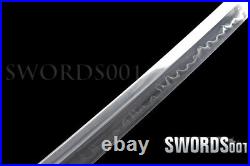
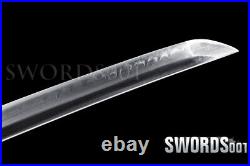

Japanese Samurai Sword Clay Hardened Real Hamon Rosewood Tachi Saya Fittings. Katana (, “sword”): A general term for the traditional sword with a curved blade longer than 60 cm (there is no upper length limit but generally they are shorter than 80 cm), worn with the edge upwards in the sash. Developed from the uchigatana and the sword of the samurai class of the Edo period (1600s to late 19th century). Samurai sword as a weapon is famous for its beautiful shape. They are used as art collection and the symbol of samurai soul. Our sword allows you to make a collection or to send to friends as a present. This katana can be taken apart fully at anytime for maintenance purposes, you can disassemble the sword by taking out the pegs from the handle. OVERALL LENGTH: 103 cm / 40.6 inch. BLADE LENGTH: 70 cm / 27.6 inch. TSUKA LENGTH: 26 cm / 10.24 inch. BLADE WIDTH: 3.2 cm / 1.26 inch. BLADE THICKNESS: 0.7 cm / 0.28. BLADE CRAFT: fully handforged, water quenching, clay tempered. BLADE MATERIAL: 1095 carbon steel. HAMON: real clay tempered line. TSUKA(HANDLE): hard wood core, hineri maki. MEKUGI: 2 bamboo pegs. TSUKA-ITO: black synthetic silk wrapping cord. SAMEGAWA: genuine white rayskin. FUCHI / KASHIRA / MENUKI: brass. TSUBA(HAND GUARD): gold & silver-plated brass. HABAKi & SEPPA: brass. SAYA: rosewood scabbard with Tachi fittings. 1 sword with saya. International Buyers – Please Note. Please contact with us before you leave feedback. We will try our best to solve the problem for you, thank you. Sometimes, you may not get our reply immediately due to the time difference among each country. However, please be assured that we’ll strive to reply you as soon as possible once we got your messages. This item is in the category “Collectibles\Knives, Swords & Blades\Swords & Sabers\Asian\Japanese”. The seller is “moranguoji2015″ and is located in this country: CN. This item can be shipped worldwide.
- Type: katana
- Tang: Full
- Handle Material: Wood
- Blade Material: Carbon Steel
- Theme: Samurai
- Dexterity: Right-Handed
- Edge: Single, Curved
- Handedness: Double-Handed
- Brand: SJ SHI JIAN
- Color: Brown
- Original/Reproduction: Original
- Country/Region of Manufacture: China
- Style: Japanese

Red real rayskin Japanese katana sword FULL TANG clay tempered SHARP can cut
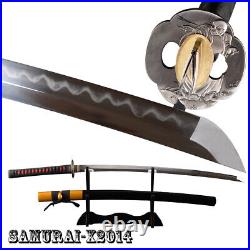
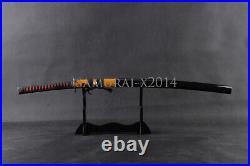
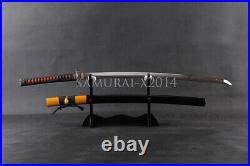
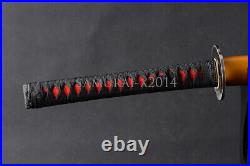
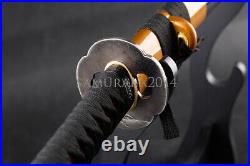
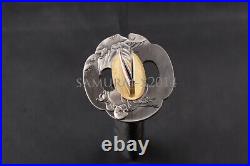
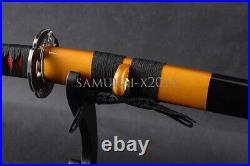
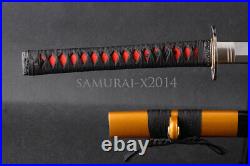
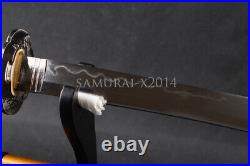
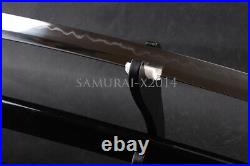
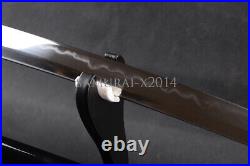
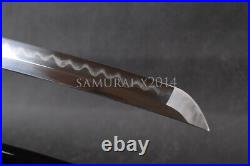

Red real rayskin Japanese katana sword FULL TANG clay tempered SHARP can cut. Item number: LQ151233 Blade thickness:0.7cm/0.28inch Tsuba :alloy Blade width:3.2cm/1.26inch Bo-hi:N0 Blade length:70cm/27.6inch Hamon: Distinct hamon Overall length: 103cm/40.6inch Tang: Full tang Saya (scabbard):Black shiny half orange with gold wood saya Blade :1095 carbon steel, clay tempered Sharpness:can cut tree or bamboo or paper Other fittings:brass habaki&high-grade brass seppa+alloy fuchi & kashira+white silk sageo Handle(tsuka):26cm/10.24inch, hard wood Wrapped with white real rayskin &white silk cord &ornamented with alloy menuki. The sword stand is not included in the package. The clay temper procedure is really complicated, although what we show you is only four steps. The blade will be set apart as 2, one is the back of the blade and the other is the cut edge side. The back side will be stick with the clay and the other side will be covered by the powder and other mixture which is protected as a secret recipe. Coz the different thickness of the back of the blade and the cut edge side, and the different of the clay mud and the mixture, when the blade cooling to be a same low temperature at the same time after the heating by high temperature, that is why the blade has a radian, and there is a clay temper wave line. The culture of Japanese sword. The sword/nihonto in Japan was called Katana. But according to the sword shape and size, there are Tachi swords, Katana, Wakizashi and short(Tanto) swords. The famous swords exsist with graceful outlooking as a weapon and some are also as arts and collections. Each Samurai warrior kept two swords on his person – a long sword/Katana, and a short sword/Wakizashi. These swords were his principal weapons gut they also were an expression of his class and personality. The Katana is more suitable for the Long distance, and the Wakizashi usually used in the short distance. Because of the length difference, the Wakizashi will take less time when you take the blade out of the saya. Share and study area. There are two kinds of martial arts which trained the use of the swords: Ken-do and Iai-do. Ken-do trains how to fight and the person being trained wears a protector and fights with a sword made of bamboo. The cross sectional shape of the grip of his bamboo sword is round. Iai-do teaches the skill of drawing a sword and striking with it. The cross sectional shape of the sword grip is oval. Iai-do teaches several techniques of how to respond in many different situations of combat. “Hagakure” (literally it is “the shadow of the leaves”) is a text of the Bushi, a class of the Samurais, which says, The way to be a Bushi is finding how to die. Loyalty and faith are most important. The Ken, or sword, is the spirit of the Bushi. To die for one’s lord and for Ken is for their honor. To be killed by the Ken is an honorable way to die. We sometimes got the question of people ask can the sword cut iron/wire? ” or “can the sword cut bone? It is not wise if you bought a Japanese sword which is sharpened to cut iron/wire, no matter how much your sword is, carbon steel or folded steel, clay tempered or not, that will make the edge of the sword turned or break down the blade. After that you will waste a lot of time to do the maintainence if that is still useful. What you see in the movie or video show that the sword can cut the hair with one breath;cut the iron/wire just like cut the mud, those are one-sided and exaggerated. They make the sword mythical. That is not impossible that there is no hurt or damage with the blade at all after Tameshigiri, just do the maintenance well. In the real life if that is in a fighting, the right way to stop the opponent is with the back of the blade but the cut edge, if you want to do a cutting test, you can cut the bamboo trees(fresh), tatami or slice paper to instead of cuttint the wire. We have the Chinese sword which can cut wire, if you are interested in, you can go and check in our store. The blade of that swords are usually very thick and heavy and sharpness is not so good as the Japanese swords. If you don’t like the original mountings, you can choose the favorite ones from the options. Handle wrapping cord and saya cord should be the same color. If you only want to change one of them to another color, please inform of it specially. International Buyers – Please Note. Please contact with us before you leave feedback. We will try our best to solve the problem for you, thank you. Sometimes, you may not get our reply immediately due to the time difference among each country. However, please be assured that we’ll strive to reply you as soon as possible once we got your messages. This item is in the category “Collectibles\Knives, Swords & Blades\Swords & Sabers\Asian\Japanese”. The seller is “moranguoji2015″ and is located in this country: CN. This item can be shipped worldwide.
- Type: katana
- Tang: Full
- Handle Material: Wood
- Blade Material: Carbon Steel
- Theme: Samurai
- Dexterity: Right-Handed
- Edge: Single, Curved
- Handedness: Double-Handed
- Authenticity: Original
- Era: 2010s
- Brand: SJ SHI JIAN
- Color: Black

Clay Tempered 1095 Carbon Steel Sword Japanese Samurai Katana Brass Fittings
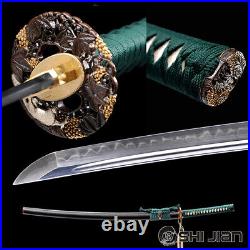
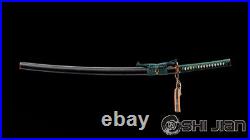
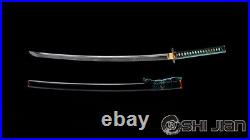
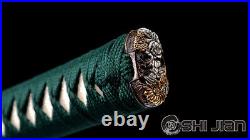
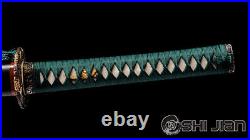

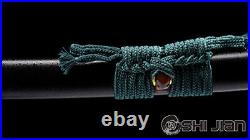
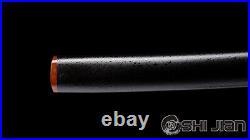
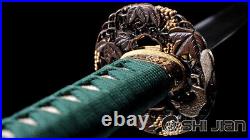
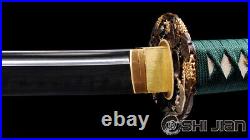
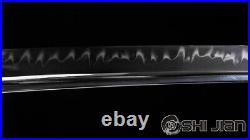
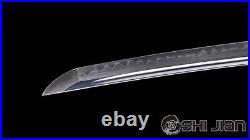

Clay Tempered 1095 Carbon Steel Sword Japanese Samurai Katana Brass Fittings. Samurai katana as a weapon is famous for its beautiful shape. They are used as art collection and the symbol of samurai soul. Our sword allows you to make a collection or to send to friends as a present. This katana can be taken apart fully at anytime for maintenance purposes, you can disassemble the sword by taking out the pegs from the handle. 103 cm / 40.6 inch. 70 cm / 27.6 inch. 26 cm / 10.24 inch. BLADE WIDTH: 3.2 cm / 1.26. BLADE THICKNESS: 0.7 cm / 0.28. BLADE CRAFT: fully handforged and polished through 11 procedures. BLADE MATERIAL: 1095 carbon steel. TSUKA(HANDLE): hard wood core, hineri maki. MEKUGI: 2 bamboo pegs. TSUKA-ITO: dark green synthetic silk cord. SAMEGAWA: white genuine rayskin. FUCHI / KASHIRA: high grade brass, golden chrysanthemum. MENUKI: high grade brass, golden. TSUBA(HAND GUARD): gold & silver plated brass. SEPPA: high quality brass. HABAKi: high quality brass. Sageo: dark green specialized synthetic silk. SAYA: matt black lacquered wooden scabbard with yellow buffalo horn Kurigata Koiguchi Koijiri. 1 sword with saya. Manual measurement error range 1-2 cm. Before being quenched, a special clay mixture can be applied onto the blade to harden the edge and obtain different hardness on the blade. The clay mixture was a special recipe and considered a crucial trade secret, guarded protectively by sword making masters. It would contain such things as feathers, powdered bones, grass, etc. And would be applied to the edge of the blade before being quenched. During quenching, a chemical reaction between the clay mixture and the hot steel occurs during the sudden temperature drop and carbon is fed into the blade in high amounts, creating an extremely tough edge. A clay hardened blade can only be quenched in water, thus increasing the defect rate even more. Another way for clay tempering is to apply clay along the blade but let edge exposed. Thus, while quenching the blade into water, the uncovered edge will cool down suddenly, but the rest of blade will cool down slowly. Such differential temperature change results in the different hardness of the blade. So the edge is tough enough to cut, where the back of blade is soft /flexible enough to absorb the impact during cutting. Such quenching process usually will leave beautiful wavy tempered line on the blade, as known as “hamon” in Japanese swords term. SWORD MOUNTINGS FOR CHOOSING. HOW TO DISASSEMBLE A JP SWORD. If you don’t like the color or the style of the mountings, you can choose different ones from the options below. Is usually a round (or occasionally squareish) guard at the end of the grip of Japanese swords. They contribute to the balance of the sword and to the protection of the hand. The tsuba was mostly meant to be used to prevent the hand from sliding onto the blade during thrusts as opposed to protecting from an opponent’s blade. Tsuka-ito is the wrapping of the tsuka and sageo?? Is a hanging cord that is passed through the hole in the kurigata?? Of a Japanese sword’s saya. Is the ray or shark skin wrapping of the tsuka (handle/hilt). The saya is a wooden scabbard for the blade; traditionally done in lacquered wood. For engraving English words, Chinese characters and Japanese Kanji. For engraving patterns dragon, lion, etc. Swords can be shaped by a variety of metalworking techniques. The primary techniques are forging and stock removal. Forging uses heat to bring the material to a malleable state. The material is then hammered to shape, typically using hammer and anvil together with specialized set and fuller tools depending on the particular technique. Stock removal shapes the sword from prepared stock that is larger in all dimensions than the finished sword by filing, grinding and cutting. After the blade has been shaped, the sword would be quenched. We quench our swords in either water or oil. Water quenching produces a tougher edge which can also be hardened further more using clay. Blades quenched in oil are still considerably hardened and do have superior flexibility compared to a water quenched blade. The more rapidly a blade cools down, the harder it becomes. Thus, when a hot blade enters the water, the water also gains heat and the blade will cool more gradually. Therefore, the first part of the blade that enters the water will be the hardest. Therefore, the technique of quenching was also very important. If a blade has any flaws from forging (air bubbles, ash), it will break immediately during the quenching process. After quenching, the sword will be quite tough and brittle, with little flexibility. To overcome this, the blade would undergo a tempering process. The blade would be reheated to a certain temperature degree then allowed to cool naturally. The blade would be slightly less tough afterward but have a greater degree of flexibility – the art would be to perfectly balance the blade for toughness, sharpness and flexibility. Finishing encompasses polishing, decorating, and crafting and assembling the hilt, guard and sheath. The swordsmith would be most concerned with the state of the blade itself and possibly decorating the blade and preparing the guards and pommel. Other artisans would likely be involved in the work of fashioning the hilt, sheath and other furniture; and in any fine decoration. When the rough blade is completed, the swordsmith turns the blade over to a polisher, whose job it is to refine the shape of a blade and improve its aesthetic value. The polishing process almost always takes longer than even crafting, and a good polish can greatly improve the beauty of a blade, while a bad one can ruin the best of blades. Early polishers used three types of stone, whereas a modern polisher generally uses seven. On high quality blades, only the back of the blade and the adjacent sides, are polished to a mirror-like surface. To bring out the grain and hamon, the center portion of the blade, and the edge are usually given a matte finish. Microscopic scratches in the surface vary, depending on hardness. Smaller but more numerous scratches in the harder areas reflect light differently from the deeper, longer scratches in the softer areas. The harder metal appears more matte than the softer, and the manner in which it scatters light is less affected by the direction of the lighting. After the blade is finished it is passed on to a mountings-maker for fashioning the hilt, sheath and other mountings. International Buyers – Please Note. This item is in the category “Collectibles\Knives, Swords & Blades\Swords & Sabers\Asian\Japanese”. The seller is “yanli22″ and is located in this country: CN. This item can be shipped worldwide.
- Type: Katana
- Handle Material: Cord Wrapped
- Tang: Full
- Dexterity: Right-Handed
- Edge: Single, Curved
- Handedness: Double-Handed
- Country/Region of Manufacture: China
- Theme: Samurai
- Brand: SJ SHI JIAN
- Color: Green
- Blade Material: Carbon Steel
- Original/Reproduction: Original
- Style: Japanese

Japanese T10 Carbon Steel Samurai Katana Sword Clay Tempered Blade Rayskin Saya
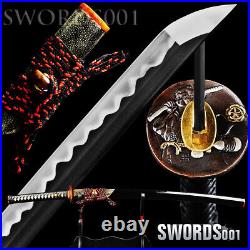
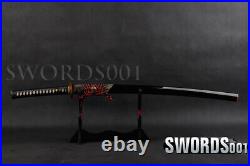
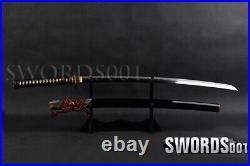
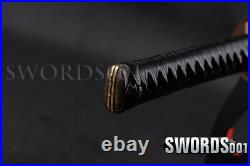
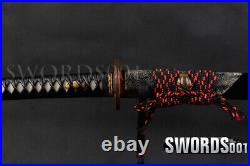
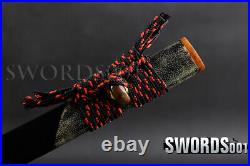
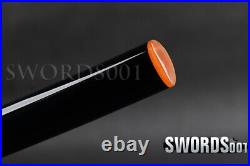
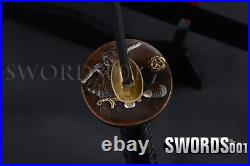
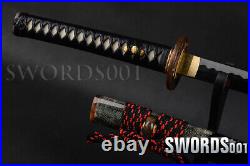
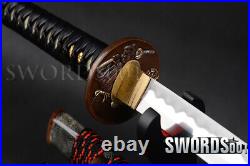
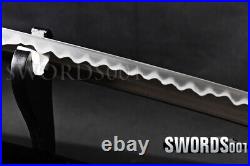
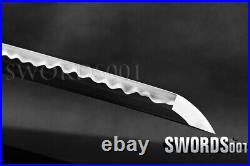

Japanese T10 Carbon Steel Samurai Katana Sword Clay Tempered Blade Rayskin Saya. Samurai katana as a weapon is famous for its beautiful shape. They are used as art collection and the symbol of samurai soul. Our sword allows you to make a collection or to send to friends as a present. This katana can be taken apart fully at anytime for maintenance purposes, you can disassemble the sword by taking out the pegs from the handle. OVERALL LENGTH: 103 cm / 40.6 inch. BLADE LENGTH: 70 cm / 27.6 inch. TSUKA LENGTH: 26 cm / 10.24 inch. BLADE WIDTH: 3.2 cm / 1.26 inch. BLADE THICKNESS: 0.7 cm / 0.28 inch. BLADE CRAFT: fully hand forged, hand polished (Shitaji togi + Shiage togi), clay hardened, water quenching. BLADE MATERIAL: T10 carbon steel. KISSAKI: medium tip (chukissaki). HAMON: real hamon, clay hardened line. POLISHING STYLE: Shiage togi + Hadori. TSUKA(HANDLE): hard wood core, hineri maki. MEKUGI: 2 bamboo pegs. TSUKA-ITO: black genuine leather cord. SAMEGAWA: genuine white rayskin. FUCHI / KASHIRA: gold plated brass, bamboo. MENUKI: gold plated brass, flowers. TSUBA(HAND GUARD): gold silver plated brass, samurai. SEPPA: high quality brass. HABAKi: high quality brass. SAGEO: black & red synthetic silk specialized cord. SAYA: glossy black lacquered wooden scabbard with amber buffalo horn Kurigata Koiguchi Koijiri. 1 sword with saya. 1 1-layer black wooden stand. The best quality of high carbon steel is T10, the carbon content was 1.03%, and the element contains a small amount of chromium, molybdenum, vanadium, after heat treatment can reach HRc 58-60 hardness. Toughness is very good, but it is not resistant to rust. It is applied to traditional european-style hunting knife, large cutting knife and military dao. Before being quenched, a special clay mixture can be applied onto the blade to harden the edge and obtain different hardness on the blade. The clay mixture was a special recipe and considered a crucial trade secret, guarded protectively by sword making masters. It would contain such things as feathers, powdered bones, grass, etc. And would be applied to the edge of the blade before being quenched. During quenching, a chemical reaction between the clay mixture and the hot steel occurs during the sudden temperature drop and carbon is fed into the blade in high amounts, creating an extremely tough edge. A clay hardened blade can only be quenched in water, thus increasing the defect rate even more. Another way for clay tempering is to apply clay along the blade but let edge exposed. Thus, while quenching the blade into water, the uncovered edge will cool down suddenly, but the rest of blade will cool down slowly. Such differential temperature change results in the different hardness of the blade. So the edge is tough enough to cut, where the back of blade is soft /flexible enough to absorb the impact during cutting. Such quenching process usually will leave beautiful wavy tempered line on the blade, as known as “hamon” in Japanese swords term. The polishing process is divided into two stages:Shitaji togi and Shiage togi. Shitaji togi is Foundation polishing, to correct any bends in the blade. Shiage togi is the stage that places the mirrorlike finish on a blade. This sword used Shiage togi, it is a elaborate process to the blade, it uses small grindstone to polish the blade by hand to make the blade mirrorlike, it is a time-consuming work, it can effectively increase the sword’s monetary, historic, artistic, and functional value. The Modern Style Polishing (Hadori Style Polishing). It is designed to highlight the aesthetics of the blade. In this style polishing, the hamon appears white against the black, shining steel and the mirror finished shinogi-ji. It is so aesthetic that it makes a blade perfect for display. The white pattern that looks like hamon is called “HADORI”. It is not a true hamon, but it is designed by polisher along the hamon to exaggerate it. When you look at the blade under a proper light, you can see the true hamon under the hadori. With the modern polishing style, you can see the blades with aesthetically “made-up face”. This polishing style was developed by a famous polisher in the early 20th century. If you don’t like the original mountings, you can choose the favorite ones from the options. Handle wrapping cord and saya cord should be the same color. If you only want to change one of them to another color, please inform of it specially. We can engrave English words, Chinese Characters on the blade for free. We can add or remove the machine-made wavy hamon for free. Usually thought be used for bloodletting only. It is also used to lighten the weight of the sword. We can add or remove Bo-hi for free. Most of our blades are sharp. We can also make the blade unsharpened for free if you require. The price varies from different swords. International Buyers – Please Note. Please contact with us before you leave feedback. We will try our best to solve the problem for you, thank you. Sometimes, you may not get our reply immediately due to the time difference among each country. However, please be assured that we’ll strive to reply you as soon as possible once we got your messages. This item is in the category “Collectibles\Knives, Swords & Blades\Swords & Sabers\Asian\Japanese”. The seller is “swords001″ and is located in this country: CN. This item can be shipped worldwide.
- Type: katana
- Tang: Full
- Handle Material: Wood
- Blade Material: Carbon Steel
- Theme: Samurai
- Dexterity: Right-Handed
- Edge: Single, Curved
- Handedness: Double-Handed
- Brand: SJ SHI JIAN
- Color: Black
- Country/Region of Manufacture: China
- Original/Reproduction: Original
- Style: Japanese

T10 Carbon Steel Clay Tempered Real Hamon Japanese warrior Sword Samurai Katana
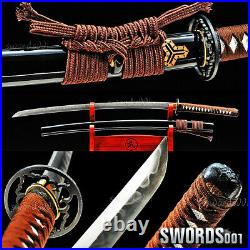
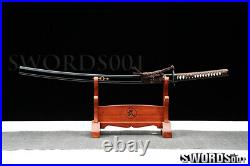
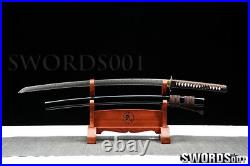
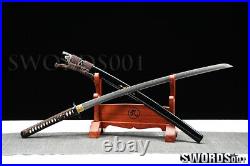
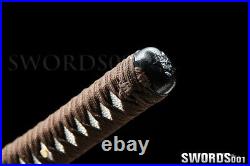
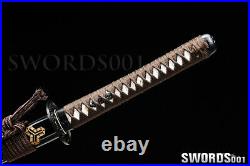
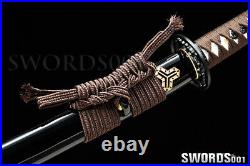
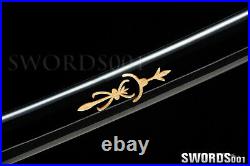
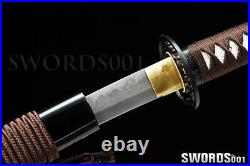
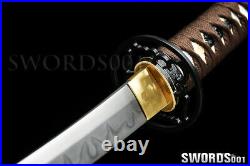
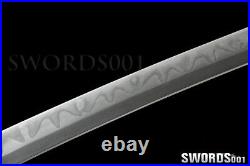
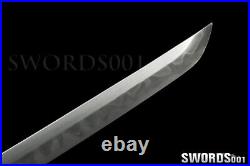

T10 Carbon Steel Clay Tempered Real Hamon Japanese warrior Sword Samurai Katana. Were one of the traditionally made Japanese swords (nihonto) that were used by the samurai of ancient and feudal Japan. The katana is characterized by its distinctive appearance: a curved, single-edged blade with a circular or squared guard and long grip to accommodate two hands. Samurai katana as a weapon is famous for its beautiful shape. They are used as art collection and the symbol of samurai soul. Our sword allows you to make a collection or to send to friends as a present. The blade of this sword is made of. The high-performance blade has very good toughness and does not deform when bent at 90 degrees. The hardness is as high as 58. Cutting the wire does not hurt the blade. It can be used in battle or for display. We would highly recommend it as a gift. Anyone would be thrilled to receive a gorgeous sword as a gift! OVERALL LENGTH: 103 cm / 40.5 inch BLADE LENGTH: 70 cm / 27.6 inch TSUKA LENGTH: 26 cm / 10.24 inch BLADE WIDTH: 3.2 cm / 1.26 inch BLADE THICKNESS: 0.7 cm / 0.28 BLADE CRAFT: fully hand forged, water quenching BLADE MATERIAL: T10 carbon steel. Clay tempered, real hamon. BLADE SHAPE: Shinogidukuri NAKAGO: full tang KISSAKI: medium (chukissaki). TSUKA(HANDLE): hard wood core, Hineri maki MEKUGI: 2 bamboo pegs TSUKA-ITO: dark brown synthetic silk wrapping cord SAMEGAWA: white rayskin FUCHI / KASHIRA / MENUKI: alloy TSUBA(HAND GUARD): alloy HABAKi & SEPPA: brass SAYA: black lacquered wooden scabbard with dark brown specialized sageo. 1 sword with saya. (No display stand and other fittings along with). Before being quenched, a special clay mixture can be applied onto the blade to harden the edge and obtain different hardness on the blade. The clay mixture was a special recipe and considered a crucial trade secret, guarded protectively by sword making masters. It would contain such things as feathers, powdered bones, grass, etc. And would be applied to the edge of the blade before being quenched. During quenching, a chemical reaction between the clay mixture and the hot steel occurs during the sudden temperature drop and carbon is fed into the blade in high amounts, creating an extremely tough edge. A clay hardened blade can only be quenched in water, thus increasing the defect rate even more. Another way for clay tempering is to apply clay along the blade but let edge exposed. Thus, while quenching the blade into water, the uncovered edge will cool down suddenly, but the rest of blade will cool down slowly. Such differential temperature change results in the different hardness of the blade. So the edge is tough enough to cut, where the back of blade is soft /flexible enough to absorb the impact during cutting. Such quenching process usually will leave beautiful wavy tempered line on the blade, as known as “hamon” in Japanese swords term. International Buyers – Please Note. Please contact with us before you leave feedback. We will try our best to solve the problem for you, thank you. Sometimes, you may not get our reply immediately due to the time difference among each country. However, please be assured that we’ll strive to reply you as soon as possible once we got your messages. This item is in the category “Collectibles\Knives, Swords & Blades\Swords & Sabers\Asian\Japanese”. The seller is “swords001″ and is located in this country: CN. This item can be shipped worldwide.
- Country/Region of Manufacture: China
- Blade Material: Carbon Steel
- Style: Japanese
- Dexterity: Ambidextrous
- Theme: Samurai
- Original/Reproduction: Original
- Type: Katana
- Edge: Single, Curved
- Color: Brown
- Handle Material: Wood
- Handedness: Double-Handed
- Tang: Full
- Brand: SJ SHI JIAN

